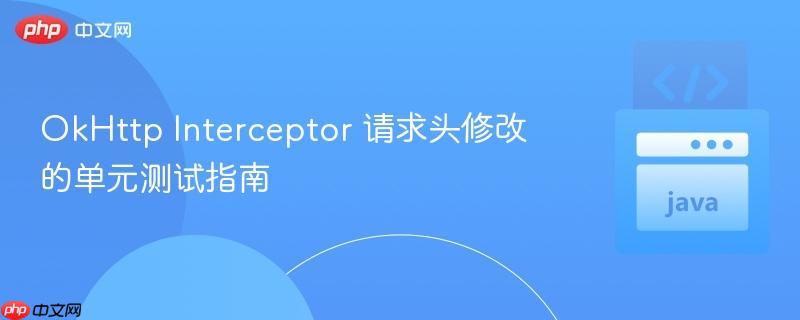
本文详细介绍了如何为 okhttp interceptor 编写有效的单元测试,特别是当拦截器用于修改请求头时。通过模拟 `interceptor.chain` 并利用 spock 框架的参数约束,我们可以精准验证拦截器是否按预期添加或修改了请求头,从而确保拦截器逻辑的正确性,避免了直接依赖实际网络请求的复杂性。
OkHttp Interceptor 请求头修改的单元测试指南
在开发基于 OkHttp 的网络应用时,Interceptor 是一个强大的功能,允许我们在请求发送前或响应接收后对请求或响应进行处理。一个常见的用例是修改请求头,例如添加认证信息。然而,如何有效地单元测试这些修改请求头的拦截器,确保其逻辑正确无误,是开发者常遇到的挑战。本文将深入探讨这一问题,并提供一套专业的测试策略。
1. 拦截器实现示例
首先,我们来看一个典型的 OkHttp Interceptor 实现,它负责向传出的请求中添加一个 Authorization 头:
package de.scrum_master.stackoverflow.q74575745; import okhttp3.Interceptor; import okhttp3.Request; import okhttp3.Response; import Java.io.IOException; /** * 一个简单的 OkHttp 拦截器,用于向请求中添加 Authorization 头。 */ class AuthRequestInterceptor implements Interceptor { @Override public Response intercept(Interceptor.Chain chain) throws IOException { Request original = chain.request(); // 构建一个新的请求,添加 Authorization 头 Request.Builder requestBuilder = original.newBuilder() .header("Authorization", "auth-value"); Request request = requestBuilder.build(); // 继续处理请求链 return chain.proceed(request); } }
这个 AuthRequestInterceptor 的核心逻辑在于获取原始请求,创建一个新的 Request.Builder,添加 Authorization 头,然后构建新请求并将其传递给 chain.proceed()。
2. 传统测试方法的局限性
许多开发者在测试拦截器时,可能会尝试通过构建一个完整的 OkHttpClient 并执行一个实际的网络请求来验证拦截器行为。例如,以下是一个尝试验证 Authorization 头是否被添加的测试代码:
// 初始的(不推荐的)测试尝试 class AuthRequestInterceptorTest extends Specification { AuthRequestInterceptor authRequestInterceptor = new AuthRequestInterceptor(); OkHttpClient okHttpClient; void setup() { // 初始化 OkHttpClient 并添加拦截器 okHttpClient = new OkHttpClient().newBuilder() .addInterceptor(authRequestInterceptor) .build(); } def "Get Authorization in to header"() { given: "一个空的请求头" HashMap<String, String> headers = new HashMap<>() when: "执行一个模拟请求" Request mockRequest = new Request.Builder() .url("http://1.1.1.1/heath-check") // 注意:这是一个模拟URL,实际不会发送请求 .headers(Headers.of(headers)) .build() Response res = okHttpClient.newCall(mockRequest).execute() then: "尝试从响应中获取 Authorization 头" // 这里的断言会失败,因为我们无法从 Response 中直接获取到 Request 的头 res.headers("Authorization") } }
这种测试方法存在一个根本性问题:Response 对象反映的是服务器返回的响应,而不是拦截器修改后发送出去的 Request。即使拦截器成功添加了请求头,我们也无法通过 res.headers(“Authorization”) 来验证它,因为这个方法检查的是响应头,而非请求头。为了有效测试拦截器对请求的修改,我们需要一种方法来“捕获”拦截器传递给 chain.proceed() 的那个被修改后的 Request 对象。
3. 推荐的单元测试策略:模拟 Interceptor.Chain
为了在隔离环境中测试拦截器,并验证其对请求的修改,最佳实践是模拟 Interceptor.Chain。通过模拟 chain,我们可以控制 chain.request() 返回的原始请求,并验证 chain.proceed() 被调用时所传入的参数。
这里我们使用 Spock 框架来演示如何实现这一策略,Spock 以其富有表现力的语法和强大的 Mocking 能力而闻名。
package de.scrum_master.stackoverflow.q74575745 import okhttp3.Interceptor import okhttp3.Request import spock.lang.Specification /** * AuthRequestInterceptor 的单元测试。 * 核心思想是模拟 Interceptor.Chain,并验证 proceed 方法被调用时传入的 Request 参数。 */ class AuthRequestInterceptorTest extends Specification { def "request contains authorization header"() { given: "一个模拟的拦截器链,它返回一个不带任何头的原始请求" // Mock Interceptor.Chain 接口 def chain = Mock(Interceptor.Chain) { // 当 chain.request() 被调用时,返回一个预设的原始请求 request() >> new Request.Builder() .url("http://1.1.1.1/heath-check") .build() } when: "运行待测试的拦截器" // 创建 AuthRequestInterceptor 实例并调用其 intercept 方法 new AuthRequestInterceptor().intercept(chain) then: "验证预期的 Authorization 头已被添加到请求中,并传递给 chain.proceed()" // 使用 Spock 的参数约束来验证 chain.proceed() 被调用了一次, // 并且传入的 Request 对象的 Authorization 头包含期望的值。 1 * chain.proceed({ Request request -> // 这里的闭包会接收到传递给 chain.proceed 的 Request 对象 // 我们可以对这个 Request 对象进行断言 request.headers("Authorization") == ["auth-value"] }) } }
测试代码解析:
-
given: “a mock interceptor chain returning a prepared request without headers”:
- 我们创建了一个 Interceptor.Chain 的 Mock 对象 (def chain = Mock(Interceptor.Chain)).
- 通过 request() >> new Request.Builder()…build(),我们定义了当 chain.request() 方法被调用时,它将返回一个预设的 Request 对象。这个 Request 代表了拦截器接收到的原始请求,它不包含任何 Authorization 头。
-
when: “running the interceptor under test”:
- 我们实例化了 AuthRequestInterceptor 并调用其 intercept(chain) 方法。此时,拦截器将执行其逻辑:获取原始请求,添加 Authorization 头,然后调用 chain.proceed()。
-
then: “the expected authorization header is added to the request before proceeding”:
- 这是最关键的部分。1 * chain.proceed(…) 表示我们期望 chain.proceed() 方法被调用一次。
- { Request request -> request.headers(“Authorization”) == [“auth-value”] } 是一个 Spock 参数约束 (Argument Constraint)。它是一个闭包,接收 chain.proceed() 方法被调用时传入的 Request 对象作为参数。在这个闭包内部,我们可以对这个 Request 对象进行任何断言。
- 我们断言 request.headers(“Authorization”) 返回的列表包含 “auth-value”,这直接验证了拦截器是否成功地将 Authorization 头添加到了请求中。
4. 关键点与注意事项
- 隔离测试: 这种方法将拦截器与实际的网络栈完全隔离,使其成为真正的单元测试。它不依赖于网络连接、服务器响应或 OkHttpClient 的复杂配置。
- 关注点分离: 测试只关注拦截器本身的逻辑:它是否正确地修改了请求。
- Spock 参数约束: Spock 的参数约束是实现这种验证的关键。它允许我们对 Mock 方法的调用参数进行详细检查,而不仅仅是检查方法是否被调用。
- 通用性: 这种模拟 Interceptor.Chain 的策略适用于所有类型的 OkHttp Interceptor 单元测试,无论是修改请求头、修改请求体、添加查询参数,还是处理响应。
- Helper Class (WebClientException): 原始问题中提到的 WebClientException 只是一个辅助异常类,在实际的拦截器测试中,如果拦截器不涉及异常处理,则无需关注。
// Helper class (如果需要,可包含在项目中) package de.scrum_master.stackoverflow.q74575745; class WebClientException extends RuntimeException { public WebClientException(Throwable cause) { super(cause); } }
5. 总结
通过模拟 Interceptor.Chain 并利用 Spock 框架强大的参数约束能力,我们可以高效且精准地单元测试 OkHttp Interceptor 对请求的修改行为。这种方法确保了拦截器逻辑的正确性,同时避免了复杂和不可靠的集成测试。掌握这一技巧,将显著提升 OkHttp 拦截器代码的质量和可维护性。


